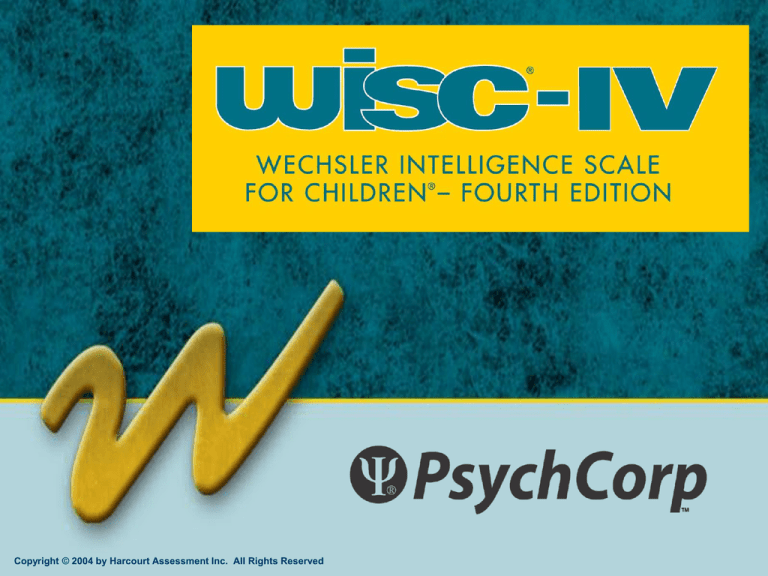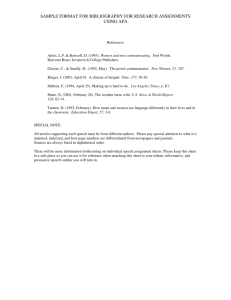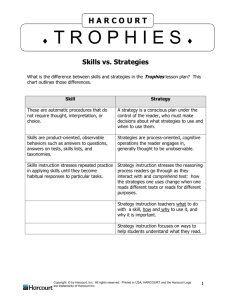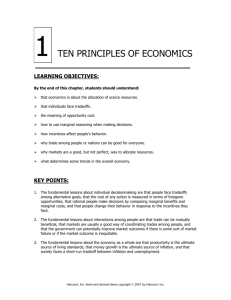
®
Copyright
© 2002
The Psychological
Corporation.
AllRights
rights reserved.
Copyright
© 2004
byby
Harcourt
Assessment
Inc. All
Reserved
WISC–IV
The KIT
Administration Manual
Technical Manual
Stimulus Book (9" X 6")
Blocks
Symbol Search/Coding
Booklet
Cancellation Booklet
Record Form
Copyright © 2004 by Harcourt Assessment, Inc. All Rights Reserved
Where Could We Be Going?
1. Elimination of the Ability-Achievement
Discrepancy
2. Emphasizing Cognitive Processing
Information provided by the IQ Test
3. Replacement of the traditional “Wait to
Fail” model
4. Increase in focus on Pre-referral
Assessment and Intervention
5. Changing of the definition of Learning
Disability
Copyright © 2004 by Harcourt Assessment, Inc. All Rights Reserved
Revision Goals
Update & Strengthen Theoretical
Foundations
Enhance Clinical Utility
Improve Psychometric Properties
Increase and Enhancing UserFriendliness
Maintain Continuity and Familiarity
Copyright © 2004 by Harcourt Assessment, Inc. All Rights Reserved
Update & Strengthen
Theoretical Foundations
Current Status of Intelligence Theory
• Use of Factor Index Scores
Emphasizes multiple factors in cognitive abilities
De-emphasizes reliance on VIQ and PIQ to characterize a
child’s overall cognitive abilities
• Consistent with WPPSI-III and WAIS-III
• Enhanced Measures of Fluid Reasoning
Tasks that involve “manipulating abstractions, rules,
generalizations, and logical relationships” require fluid
intelligence (Carroll, 1993, p. 583). MR, PCO, and WR
developed to enhance the measures of fluid intelligence
Copyright © 2004 by Harcourt Assessment, Inc. All Rights Reserved
Update & Strengthen
Theoretical Foundations
• Enhanced Measures of Working Memory
Emphasizes the importance of working memory
in learning
Focuses on more “active” types of working
memory
• Enhanced Measures of Processing Speed
Targets role as “mediator” in cognitive
functioning and learning
Recognizes impact as predictor of reading
comprehension
Copyright © 2004 by Harcourt Assessment, Inc. All Rights Reserved
Enhanced Clinical Utility
Increasing Number of Special
Group Validity Studies
Updating Statistical Linkage to
Other Cognitive Measures and
Measures of Achievement
Copyright © 2004 by Harcourt Assessment, Inc. All Rights Reserved
Enhancing Clinical Utility
Increased and Enhanced Clinical Validity Studies
•
•
•
•
•
•
•
•
Mental Retardation – Mild
Mental Retardation – Moderate
Learning Disorder – Reading
Learning Disorder – Reading,
Writing
Learning Disorder – Reading,
Writing, and Math
Learning Disorder – Math
Receptive Language Disorder
Receptive/Expressive Language
Disorder
Copyright © 2004 by Harcourt Assessment, Inc. All Rights Reserved
•
•
•
•
•
•
•
ADHD
ADHD/LD Combined
Motor Impaired
Autism/Aspergers
TBI – Open
TBI – Closed
Intellectually Gifted
Enhancing Clinical Utility
Increased Linkage and Correlations with Other
Assessments
Equivalency studies with WISC-III, WAIS-III, WPPSI-III,
WASI, approximately 200 cases each, counterbalanced
WIAT-II Link, 550 cases
CMS Link, 110 cases
Adaptive Behavior Assessment System (ABAS) Link, 200
cases each for Parent/Teacher forms
Bar-ON EQ, 200 cases
Gifted Rating Scale, 240 cases
Copyright © 2004 by Harcourt Assessment, Inc. All Rights Reserved
Improved Psychometric Properties
Updating Norms
Improving Evidence of Reliability
and Validity
Extending Floors and Ceilings
Re-examining Item Bias
Copyright © 2004 by Harcourt Assessment, Inc. All Rights Reserved
Increased User-Friendliness
Decreasing Testing Time
Simplifying Administration and
Scoring Procedures
Improving Stimulus Materials
Eliminating the Object Assembly subtest
Dividing and Reorganizing the Manual
Dividing and Reorganizing the
Record Form
Copyright © 2004 by Harcourt Assessment, Inc. All Rights Reserved
Reasons for Updating Norms
Improvement in Education System
Improved nutrition
Better health conditions
Increased dissemination of information
Demographic shifts
• Hispanic population growth (11% to 15%)
• Regional growth (Growth in West and South
at the expense of NE)
Copyright © 2004 by Harcourt Assessment, Inc. All Rights Reserved
®
Basic Description of
the New WISC–IV
Copyright
© 2002
The Psychological
Corporation.
AllRights
rights reserved.
Copyright
© 2004
byby
Harcourt
Assessment
Inc. All
Reserved
WISC–IV Model
Copyright © 2004 by Harcourt Assessment, Inc. All Rights Reserved
Basic Description of the WISC–IV
Individual Administration
Assessment of Cognitive Functioning in
Children 6–16 Years
• 10 Subtests to obtain FSIQ
• 10 Subtests to obtain Index Scores
• 3 Core Verbal and 3 Core Perceptual Reasoning
Subtests
• 2 Core Working Memory and 2 Core Processing
Speed Subtests
Administration time: median = 67 minutes
Copyright © 2004 by Harcourt Assessment, Inc. All Rights Reserved
Verbal Comprehension Index
Core Subtests:
• Similarities
• Vocabulary
• Comprehension
Supplementary Subtests:
• Information
• Word Reasoning
Copyright © 2004 by Harcourt Assessment, Inc. All Rights Reserved
Perceptual Reasoning Index
Core Subtests:
• Block Design
• Picture Concepts
• Matrix Reasoning
Supplementary Subtest:
• Picture Completion
Copyright © 2004 by Harcourt Assessment, Inc. All Rights Reserved
Working Memory Index
Core Subtests:
• Digit Span
• Letter-Number Sequencing
Supplementary Subtest:
• Arithmetic
Copyright © 2004 by Harcourt Assessment, Inc. All Rights Reserved
Processing Speed Index
Core Subtests:
• Coding
• Symbol Search
Supplementary Subtest:
• Cancellation
Copyright © 2004 by Harcourt Assessment, Inc. All Rights Reserved
Order of WISC-IV Subtests
Core Subtests
Block Design
Similarities
Digit Span
Picture Concepts
Coding
Vocabulary
Letter – Number
Sequencing
Matrix Reasoning
Comprehension
Symbol Search
Copyright © 2004 by Harcourt Assessment, Inc. All Rights Reserved
Supplemental Subtests
11. Picture Completion
12. Cancellation
13. Information
14. Arithmetic
15. Word Reasoning
Block Design
14 items—two parts
• 3 new items designed to
improve ceiling and item
difficulty gradient
• No time-bonus administration
option
Copyright © 2004 by Harcourt Assessment, Inc. All Rights Reserved
Block Design
Any pronounced rotation of 30o or more is
considered an error.
Correct only the first rotation that occurs by
rotating the blocks to the correct position and
saying, “See, it goes this way.” Continue
subtest administration accordingly.
Copyright © 2004 by Harcourt Assessment, Inc. All Rights Reserved
Block Design
Designed to measure the ability to
analyze and synthesize abstract visual
stimuli and nonverbal concept formation.
Involves nonverbal fluid reasoning,
visual perception and organization,
visual-motor coordination, spatial
visualization, and the ability to separate
figure and ground in visual stimuli.
Copyright © 2004 by Harcourt Assessment, Inc. All Rights Reserved
Similarities
Core Subtest
23 items
• 11 new items–Scoring criteria modified
• Practice items reduced from 5 to 2
“In what way are RED and BLUE alike?”
Copyright © 2004 by Harcourt Assessment, Inc. All Rights Reserved
Similarities
Designed to measure fluid verbal reasoning
and concept formation.
Also involves auditory comprehension,
memory, distinguishing non-essential and
essential features, and verbal expression.
Copyright © 2004 by Harcourt Assessment, Inc. All Rights Reserved
Digit Span
Digit Span Forward requires the child to
repeat numbers in the same order the
examiner reads aloud.
Digit Span Backward requires the child to
repeat the numbers in the reverse order
presented by the examiner.
Copyright © 2004 by Harcourt Assessment, Inc. All Rights Reserved
Digit Span
Designed as a measure of working memory (initial
encoding & mental manipulation), auditory shortterm memory, sequencing skills, attention, and
concentration.
Digit Span Forward involves initial encoding,
attention,and auditory processing.
Digit Span Backward involves mental
manipulation, transformation of information, and
visuospatial imaging.
Shift from the Forward to the Backward task
requires cognitive flexibility and mental alertness.
Copyright © 2004 by Harcourt Assessment, Inc. All Rights Reserved
Picture Concepts
28 items–The child is presented with two or
three rows of pictures and chooses one picture
from each row to form a group with a common
characteristic.
Copyright © 2004 by Harcourt Assessment, Inc. All Rights Reserved
Picture Concepts
Designed to measure abstract, fluid, and
categorical reasoning ability.
Solutions to easier items are generally
attained by reasoning based on concrete
representations, and the solutions to
more difficult items are obtained by
reasoning based on more abstract
representations.
Copyright © 2004 by Harcourt Assessment, Inc. All Rights Reserved
Coding
Measures processing speed
Involves short-term memory, learning
ability, visual perception, visual-motor
coordination, visual scanning ability,
cognitive flexibility, attention, motivation
and visual and sequential processing.
Copyright © 2004 by Harcourt Assessment, Inc. All Rights Reserved
Vocabulary
36 items
• 4 picture items designed to extend the floor of
the subtest.
• 32 verbal items—5 new items to improve item
difficulty gradient. Scoring modifications on
all items.
“What is a car?”
Copyright © 2004 by Harcourt Assessment, Inc. All Rights Reserved
Vocabulary
Designed to assess a child’s word knowledge
and degree of language development. Also
designed to measure a child’s fund of
knowledge, learning ability, long-term memory,
and verbal concept formation.
Other abilities that may be utilized include
auditory perception and comprehension,
verbal conceptualization, abstract thinking, and
verbal expression.
Copyright © 2004 by Harcourt Assessment, Inc. All Rights Reserved
Letter-Number Sequencing
Measures Working Memory
Adapted from the WAIS–III
Child is presented a series of numbers
and letters. The child repeats numbers
then letters in order.
Involves sequencing, mental manipulation,
attention, short-term auditory memory,
visuospatial imaging, and processing speed.
Copyright © 2004 by Harcourt Assessment, Inc. All Rights Reserved
Letter-Number Sequencing
Example:
Examiner says, “7 K 3 D 9”
Child responds, “3 7 9 D K”
Copyright © 2004 by Harcourt Assessment, Inc. All Rights Reserved
Definitions of Fluid Reasoning
It is the “ability to perform mental operations, such
as the manipulation of abstract symbols”
Sternberg, 1995
It is Gf from the Horn–Catell model
Catell, 1941; Horn, 1968
It encompasses the abilities of reasoning under
novel conditions: general reasoning, figural
relations, semantic relations, classifications,
concept formation.
Horn & Noll, 1997
Copyright © 2004 by Harcourt Assessment, Inc. All Rights Reserved
Matrix Reasoning
35 items—child completes matrices from
five response options.
Copyright © 2004 by Harcourt Assessment, Inc. All Rights Reserved
Matrix Reasoning
Measure of fluid intelligence and a
reliable estimate of general intellectual
ability.
Four types of matrices including:
continuous and discrete pattern
completion, classification, analogical
reasoning, and serial reasoning.
Copyright © 2004 by Harcourt Assessment, Inc. All Rights Reserved
Comprehension
21 items—all items require the child to
answer questions.
11 new items and 10 items retained.
“Why do people brush their teeth?”
Copyright © 2004 by Harcourt Assessment, Inc. All Rights Reserved
Comprehension
Measures verbal reasoning and
conceptualization, the ability to evaluate
and utilize past experiences, verbal
comprehension and expression, and
the ability to demonstrate practical
information.
Involves knowledge of conventional
standards of behavior, social judgment,
maturity, and common sense.
Copyright © 2004 by Harcourt Assessment, Inc. All Rights Reserved
Symbol Search
Nonverbal Measure of Processing Speed
Uses abstract symbols
2 target symbols per item
5 search symbols per item
Equal difficulty across all items
Difficulty range from .85 to 1.0
Copyright © 2004 by Harcourt Assessment, Inc. All Rights Reserved
Symbol Search
Involves processing speed, short-term
visual memory, visual-motor coordination,
cognitive flexibility, visual discrimination,
and concentration.
May also tap auditory comprehension,
perceptual organization, and planning
and learning ability.
Copyright © 2004 by Harcourt Assessment, Inc. All Rights Reserved
Picture Completion
38 items—all artwork
has been redrawn,
enlarged and
colorized.
25 items retained,
13 new items to
improve difficulty
gradient.
Copyright © 2004 by Harcourt Assessment, Inc. All Rights Reserved
Picture Completion
Now a Supplemental Subtest.
Measures visual perception and
organization, concentration, and visual
recognition of essential details of objects.
Copyright © 2004 by Harcourt Assessment, Inc. All Rights Reserved
Cancellation
Supplemental Subtest
Measure of Processing Speed
2 forms (Random, Structured)
Forms share identical target locations.
Targets are animals.
Foils are common, non-animal objects.
Copyright © 2004 by Harcourt Assessment, Inc. All Rights Reserved
Random vs. Structured
(Targets in same location)
Measures processing speed, visual selective
attention, vigilance, and visual neglect.
Copyright © 2004 by Harcourt Assessment, Inc. All Rights Reserved
Information
33 items
• 11 new verbal items—22 retained
from WISC–III. Some scoring
modifications.
“Show me your foot.”
Copyright © 2004 by Harcourt Assessment, Inc. All Rights Reserved
Information
Designed to assess a child’s ability to
acquire, retain, and retrieve general factual
knowledge, commonly referred to as general
fund of knowledge.
Involves crystallized intelligence, long-term
memory, and the ability to retain and retrieve
knowledge from school and environment.
Also involves auditory perception and
comprehension and verbal expressive ability.
Copyright © 2004 by Harcourt Assessment, Inc. All Rights Reserved
Arithmetic
Supplemental Working Memory Subtest
The child mentally solves a series of orally
presented arithmetic problems within a
specified time limit.
“Count these birds with your finger.
Count them out loud so I can hear you.”
Copyright © 2004 by Harcourt Assessment, Inc. All Rights Reserved
Arithmetic
Involves mental manipulation,
concentration, attention, short- and
long-term memory, numerical reasoning
ability, and mental alertness.
May also involve sequencing, fluid
reasoning, and logical reasoning.
Copyright © 2004 by Harcourt Assessment, Inc. All Rights Reserved
Word Reasoning
24 items—Examiner reads increasingly specific
series of one to three clues and the child is
asked to identify the common object or concept.
“Tell me what I’m thinking of. This is an animal
that goes ‘woof.’ What is it?”
“Tell me what I’m thinking of.
1. This has a long handle…
2. and is used with water to clean the floor.
Copyright © 2004 by Harcourt Assessment, Inc. All Rights Reserved
Word Reasoning
Measures verbal deductive reasoning.
Skills that contribute to success include verbal
comprehension, expressive language ability,
verbal abstraction, domain knowledge,
analogic and general reasoning, ability to
utilize contextual and syntax information,
generate alternative concepts, and integrate
and synthesize different types of information.
Other contributing skills include long-term
memory, cognitive flexibility, and trial-and-error
learning.
Copyright © 2004 by Harcourt Assessment, Inc. All Rights Reserved
®
Technical Development
and Standardization
Copyright
© 2002
The Psychological
Corporation.
AllRights
rights reserved.
Copyright
© 2004
byby
Harcourt
Assessment
Inc. All
Reserved
Demographic Stratification
Variables
Age
Sex
Race/Ethnicity
Parent Education Level
Geographic Region
Copyright © 2004 by Harcourt Assessment, Inc. All Rights Reserved
Stratification Variables: Age
6:00 7:00 8:00 9:00 10:00 11:00 12:00 13:00 14:00 15:00 16:00
6:11 7:11 8:11 9:11 10:11 11:11 12:11 13:11 14:11 15:11 16:11
WISC
200 200 200 200 200 200
- IV
Copyright © 2004 by Harcourt Assessment, Inc. All Rights Reserved
200 200 200 200 200
Stratification Variables: Sex
Female n = 1100; Male n = 1100
Age Group
Copyright © 2004 by Harcourt Assessment, Inc. All Rights Reserved
Stratification Variables: Race/Ethnicity
Copyright © 2004 by Harcourt Assessment, Inc. All Rights Reserved
Stratification Variables: Parent
Education Level
Copyright © 2004 by Harcourt Assessment, Inc. All Rights Reserved
Stratification Variables: Geographic
Region
Copyright © 2004 by Harcourt Assessment, Inc. All Rights Reserved
Exclusionary Criteria for
Standardization Sample
Copyright © 2004 by Harcourt Assessment, Inc. All Rights Reserved
Additional Sampling Issues
Ethnicity/Bias Oversample during Tryout Phase
Education Level Oversample
Validity Data From Clinical Groups
Correlational Data From Other Tests
Test–Retest Data
Copyright © 2004 by Harcourt Assessment, Inc. All Rights Reserved
®
Evidence of Reliability
Copyright
© 2002
The Psychological
Corporation.
AllRights
rights reserved.
Copyright
© 2004
byby
Harcourt
Assessment
Inc. All
Reserved
Concept of Reliability
Refers to the accuracy, consistency, and
stability of test scores across situations
The difference between the hypothetical
true score and the individual’s obtained
test score is measurement error.
A reliable test will have relatively small
measurement error and consistent
measurement results within one
administration and on different occasions.
Copyright © 2004 by Harcourt Assessment, Inc. All Rights Reserved
Evidence of Internal Consistency
The reliability coefficients for WISC–IV
composite scales range from .88
(Processing Speed) to .97 (Full Scale).
The average reliability coefficients of the
WISC–IV subtests range from .79 (Symbol
Search and Cancellation) to .90 (Letter–
Number Sequencing). All remaining
reliability coefficients range from .80 (Word
Reasoning) to .89 (Vocabulary and Matrix
Reasoning).
Copyright © 2004 by Harcourt Assessment, Inc. All Rights Reserved
Reliability Coefficients of the Subtests,
Process Scores, and Composite Scales, by
Age Group
Copyright © 2004 by Harcourt Assessment, Inc. All Rights Reserved
Reliability Coefficients of the Subtests and
Process Scores for Special Groups
Copyright © 2004 by Harcourt Assessment, Inc. All Rights Reserved
Evidence of Test–Retest
Reliability
Copyright © 2004 by Harcourt Assessment, Inc. All Rights Reserved
Evidence of Interscorer
Reliability
All WISC–IV protocols were double-scored by two
independent scorers, and evidence of interscorer
agreement was obtained using the normative sample.
Because the scoring criteria for most of the subtests
are simple and objective, interscorer agreement is
very high, ranging from .98 to .99.
Total subtest scores were used in the analysis,
interscorer reliabilities were .98 for Similarities, .98 for
Vocabulary, .95 for Comprehension, .96 for
Information, and .97 for Word Reasoning.
Copyright © 2004 by Harcourt Assessment, Inc. All Rights Reserved
®
Evidence of Validity
Copyright
© 2002
The Psychological
Corporation.
AllRights
rights reserved.
Copyright
© 2004
byby
Harcourt
Assessment
Inc. All
Reserved
Exploratory Factor Pattern Loadings
for Core Subtests
Copyright © 2004 by Harcourt Assessment, Inc. All Rights Reserved
Exploratory Factor Pattern Loadings for
Core and Supplemental Subtests
Copyright © 2004 by Harcourt Assessment, Inc. All Rights Reserved
®
Clinical Validity Studies
Copyright
© 2002
The Psychological
Corporation.
AllRights
rights reserved.
Copyright
© 2004
byby
Harcourt
Assessment
Inc. All
Reserved
Clinical Linking Studies
Mental Retardation – Mild
Mental Retardation – Moderate
Learning Disorder – Reading
Learning Disorder – Reading, Writing
Learning Disorder – Reading, Writing, Math
Learning Disorder – Math
WISC-IV
WISC-IV
WISC-IV Integrated
Receptive Language Disorder
Receptive/Expressive Language Disorder
WISC-IV
Copyright © 2004 by Harcourt Assessment, Inc. All Rights Reserved
WISC-IV Integrated
WIAT-II
WISC-IV Integrated
PAL
CELF-4
Clinical Linking Studies
ADHD
ADHD/LD Combined
WISC-IV
WISC-IV Integrated
BROWN ADHD
Motor Impaired
WISC-IV
Autism/Aspergers
WISC-IV
WISC-IV Integrated
TBI – Open
WISC-IV
WISC-IV Integrated
NEPSY
D-KEFS
TBI – Closed
WISC-IV
WISC-IV Integrated
NEPSY
D-KEFS
Gifted
WISC-IV
D-KEFS
Copyright © 2004 by Harcourt Assessment, Inc. All Rights Reserved
EQ
GRS
®
The Record Form
Copyright
© 2002
The Psychological
Corporation.
AllRights
rights reserved.
Copyright
© 2004
byby
Harcourt
Assessment
Inc. All
Reserved
Calculating Examinee’s Age
1. Enter Date of Testing in format Year/Month/Day
2. Enter Date of Birth in format Year/Month/Day
3. Subtract Day, then Month, then Year.
(All months are assumed to have 30 days.)
4. DO NOT round up.
Copyright © 2004 by Harcourt Assessment, Inc. All Rights Reserved
Completing the Summary Page
1. Calculate Subtest Total Raw
Scores
2. Convert Total Raw Scores to
Scaled Scores
3. Obtain Sums of Scaled Scores
4. Determine the Composite Scores
5. Plot the Score Profiles
Copyright © 2004 by Harcourt Assessment, Inc. All Rights Reserved
Sample Completed Summary Page
Copyright © 2004 by Harcourt Assessment, Inc. All Rights Reserved
Sample Conversion of Raw
Scores to Scaled Scores
Copyright © 2004 by Harcourt Assessment, Inc. All Rights Reserved
Completed Analysis Page
Copyright © 2004 by Harcourt Assessment, Inc. All Rights Reserved
Completed Analysis Page
Copyright © 2004 by Harcourt Assessment, Inc. All Rights Reserved
®
Scoring the WISC–IV
Copyright
© 2002
The Psychological
Corporation.
AllRights
rights reserved.
Copyright
© 2004
byby
Harcourt
Assessment
Inc. All
Reserved
WISC–IV Software Related
Information
1. When a WISC–III Scoring Assistant user installs
WISC–IV, the WISC–III raw scores window and
WISC–III reports will still be available. In other
words, WISC–IV is not an upgrade of WISC–III. It
is added to the platform as a new and separate
product.
2. The WIAT–II Scoring Assistant is automatically
updated to perform discrepancy analysis reporting
with WISC–IV when WISC–IV is installed. A
separate WIAT–II update CD is
not necessary.
Copyright © 2004 by Harcourt Assessment, Inc. All Rights Reserved
Wechsler Software Purchase Plan
New Customers
I HAVE
No Platform Product
I WANT THIS REPORT CAPABILITY
I NEED TO BUY
- WISC-IV Scoring Assistant Reports
WISC-IV Scoring Assistant
- WISC-IV & WIAT-II Scoring Assistant Reports
WISC-IV Scoring Assistant
and the WIAT-II Scoring
Assistant
- WISC-IV Scoring Assistant & Writer Reports
WISC-IV Writer
- WISC-IV & WIAT-II Scoring Assistant & Writer
Reports
WISC-IV Writer and the
WIAT-II Scoring Assistant
- WPPSI-III Scoring Assistant
WPPSI-III Scoring Assistant
- WPPSI-III & WIAT-II Scoring Assistant Reports
WPPSI-III Scoring
Assistant and the WIAT-II
Scoring Assistant
- WPPSI-III & WIAT-II Scoring Assistant & Writer
Reports
WPPSI-III Writer and the
WIAT-II Scoring Assistant
Copyright © 2004 by Harcourt Assessment, Inc. All Rights Reserved
Wechsler Software Purchase Plan
Existing Customers
I HAVE
WIAT-II Scoring Assisant
I WANT THIS REPORT CAPABILITY
WISC-IV Scoring Assistant
UPGRADE PRICE?
- WISC-IV & WIAT-II Scoring Assistant Reports
WISC-IV Scoring Assistant
No
- WISC-IV & WIAT-II Scoring Assistant Reports
- WISC-IV & WIAT-II Writer Reports
WISC-IV Writer
No
- WISC-III & WIAT-II Writer Reports
WISC-III-WIAT-II Upgrade
to Writer
Yes
WISC-IV Scoring Assistant
No
- WISC-IV & WIAT-II Writer Reports
WISC-IV Writer
No
- WISC-IV & WIAT-II Scoring Assistant Reports
WISC-IV Scoring Assistant
No
- WISC-IV & WIAT-II Writer Reports
WISC-IV Writer
No
- WISC-IV & WIAT-II Scoring Assistant Reports
WIAT-II Scoring Assistant
No
- WISC-IV Writer Reports
WISC-IV Upgrade to Writer
Yes
WISC-III-WIAT-II Scoring
Assistant
- WISC-IV & WIAT-II Scoring Assisant Reports
WISC-III-WIAT-II Writer
I NEED TO BUY
Copyright © 2004 by Harcourt Assessment, Inc. All Rights Reserved
Software Packaging:
A Modular Approach
Future of software on the
PsychCorpCenter (PCC) is taking
modular approach (one
instrument per application)
e.g.,
Discrepan
y Analysis
Reporting
Allows for ease in maintenance
and serviceability
Still allows for report integration
across instruments (WISC–IV—
WIAT–II, WISC-III—WIAT–II,
WPPSI–III—WIAT–II discrepancy
analysis)
Copyright © 2004 by Harcourt Assessment, Inc. All Rights Reserved
®
Interpretation
Copyright
© 2002
The Psychological
Corporation.
AllRights
rights reserved.
Copyright
© 2004
byby
Harcourt
Assessment
Inc. All
Reserved
Interpretation of WISC–IV
Scores
Subtest Scaled Scores:
Mean = 10, SD = 3
IQ and Index Scores:
Mean = 100, SD = 15
Individual’s Rank Compared to
Normative Group
FSIQ Score: Overall Ability
Index Scores: Breakdown of Abilities
Subtest Scores: Strengths and Weaknesses
Copyright © 2004 by Harcourt Assessment, Inc. All Rights Reserved
Enhancement of Clinical
Interpretation
Qualitative Descriptions of FSIQ Score and
Index Scores
Confidence Intervals
Additional Tables for Determining
Statistical Significance
Base Rates for Discrepancy Scores
(Overall and by Ability Level)
Age-Corrected Subtest Scaled Scores
Discrepancies Between Digit Span Forward
and Backward
Copyright © 2004 by Harcourt Assessment, Inc. All Rights Reserved
Conceptualization Structure
Core Input Requirements
• e.g., Hearing, Vision, Motor
Core Processing and Output Requirements
• Minimum verbal expression to maximum verbal
expression required.
• Minimum motor output required to maximum motor
output required.
• Maximum structure and organization provided to
minimum amount of structure and organization required.
• Maximum amount of contextual information provided to
minimum amount of contextual information provided.
Copyright © 2004 by Harcourt Assessment, Inc. All Rights Reserved
Conceptualization Structure
Characteristics of Response
• Correct, Efficient, and Automatic
• Incorrect, Efficient, and Automatic
• Correct, Inefficient, and Effortful
• Incorrect, Inefficient, and Effortful
Copyright © 2004 by Harcourt Assessment, Inc. All Rights Reserved
Qualitative Descriptions of IQ Scores
Score
Classification
130 and above
120–129
110–119
90–109
80–89
70–79
69 and below
Very Superior
Superior
High Average
Average
Low Average
Borderline
Extremely Low
Copyright © 2004 by Harcourt Assessment, Inc. All Rights Reserved
% Included in Theoretical
Normal Curve
2.2
6.7
16.1
50.0
16.1
6.7
2.2
Using the Qualitative Descriptions
Relative to individuals of comparable age,
this individual is currently functioning in
the [descriptive classification] range on a
standardized measure of intelligence.
Copyright © 2004 by Harcourt Assessment, Inc. All Rights Reserved
Example of Subtest Profiles
LNS = DS = A
Subtests
Index
Copyright © 2004 by Harcourt Assessment, Inc. All Rights Reserved
LNS > DS > A
Subtests
Index
Patterns and Profiles of
Performance
Profile analyses can be used to evaluate
scatter within or among FSIQ, Index Scores
and Subtests.
Profile analyses can be used to generate
hypotheses that are either corroborated or
refuted by other evaluation results, such as
background information,
direct behavioral observation,
additional evaluation,
consistency with injury or disorder.
Copyright © 2004 by Harcourt Assessment, Inc. All Rights Reserved
WISC-IV Levels of Performance
FSIQ
VCI
Similarities
Vocabulary
Comprehension
Information
Word Reasoning
PRI
Block Design
Matrix Reasoning
Picture Concepts
Picture Completion
WMI
PSI
Digit Span
Letter-Number
Sequencing
Arithmetic
Coding
Symbol Search
Cancellation
Subtests in Italics are Supplemental
Copyright © 2004 by Harcourt Assessment, Inc. All Rights Reserved
Statistical Versus Clinical
Significance
“Although statistically significant differences
between scores can occur in many clinical groups, the
same differences may also occur frequently in the
normally functioning population.”
Matarazzo, 1990
Base rate information provides a basis for
estimating the rarity or commonness of the
examinee’s obtained difference within the normal
adult population.
Copyright © 2004 by Harcourt Assessment, Inc. All Rights Reserved
Statistical Significance of
Index Score Differences
A statistically significant difference between
scores, e.g., between the VCI and the PRI, refers
to the likelihood that obtaining such a difference by
chance is very low (e.g., p < .05) if the true
difference between the scores is 0 (Matarazzo &
Herman, 1985).
The level of significance reflects the level of
confidence the examiner can have that the
difference between the scores, called the
difference score, is a true difference.
Copyright © 2004 by Harcourt Assessment, Inc. All Rights Reserved
Frequency of Index Score
Differences
The prevalence or frequency of an observed score
difference in the general population is also referred to
as the base rate. Often the difference between an
individual’s composite scores (e.g., VCI and PRI) is
significant in the statistical sense, but is not infrequent.
The statistical significance of differences between
scores and the rarity of the difference are two different
issues and consequently have different implications for
test interpretation. (Matarazzo & Herman, 1985; Payne
& Jones, 1957; Sattler, 2001; and Silverstein, 1981.)
Copyright © 2004 by Harcourt Assessment, Inc. All Rights Reserved
Frequency of Index Score
Differences
Index score discrepancies of the WISC–IV standardization
sample vary as a function of ability level, not age. Table
B.2 provides the base rate data by overall standardization
sample and by ability level.
Table B.2 also provides the base rate data by the direction
of the difference and is based on findings that show the
percentages of the score differences are not identical in
both directions (Sattler, 2001). For example, for children
whose FSIQ is 79 points or less, 16.7% obtained PRI
scores 15 or more points higher than their VCI scores,
whereas only 10.2% obtained VCI scores 15 or more
points higher than their PRI scores.
Copyright © 2004 by Harcourt Assessment, Inc. All Rights Reserved
Differences Between Subtest
Scaled Scores
An evaluation of the variability helps the
practitioner identify the strengths and
weaknesses of the child’s cognitive functioning.
As with differences between the index scores,
the interpretation of a particular subtest score
as especially high or low should take into
account the statistical significance of the
observed difference and estimates of
population base rates.
Copyright © 2004 by Harcourt Assessment, Inc. All Rights Reserved
®
Related Assessments
in Development
Copyright
© 2002
The Psychological
Corporation.
AllRights
rights reserved.
Copyright
© 2004
byby
Harcourt
Assessment
Inc. All
Reserved
WISC–IV Spanish
To be normed entirely in the U.S.
Items adapted from WISC–IV
Where adaptation is impossible,
parallel items have been created.
Norms equated to full US population.
Available Winter 2004 / 2005
Copyright © 2004 by Harcourt Assessment, Inc. All Rights Reserved
WISC–IV Integrated
WISC–IV as a Process Instrument
Data-based testing-the-limits
Multiple-choice versions of WISC–IV
verbal subtests and Block Design
Spatial Span – Spatial Working
Memory
Elithorn Mazes – executive functions
Frequencies of error types
Copyright © 2004 by Harcourt Assessment, Inc. All Rights Reserved
For More Information:
If you need product information or have questions,
concerns, or suggestions for PsychCorp, please call
us at 1-800-872-1726, fax us at 1-800-232-1223, or email us at Customer_Care@Harcourt.com . We
welcome any comments or questions you may have.
Copyright © 2004 by Harcourt Assessment, Inc. All Rights Reserved









